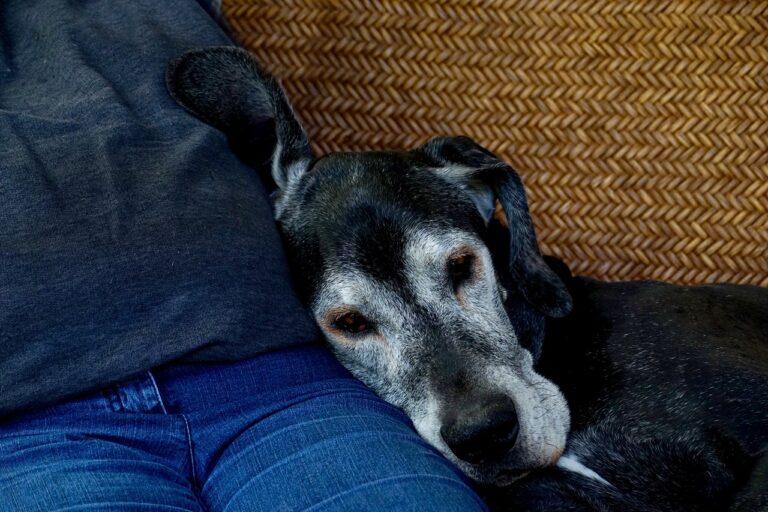It’s not uncommon for aging dogs to get a bit grumpier. Pain and diminished sensory capacity can make the whole world seem more threatening.
So how do you stop aggression in a senior dog? In today’s Ask a Behavior Consultant, we cover this tough topic.
Can you train an aggressive, disabled senior dog? I’ve moved into a home with two senior dogs with my French bulldog. The Boston terrier is blind, deaf, demented, and incontinent. He also attacks the bulldog so much so that we have to keep them separated.
– Sincerely, End of My Rope
This is definitely a tough situation. Here’s how I’d tackle it if I was working with a client:
1. Keep Everyone Safe
Our writer has already done a good job of this – she’s keeping the dogs separate. That’s a necessary first step to stop the “bad blood” between the dogs from getting worse.
Keep doing that.
Baby gates, exercise pens, and crates are all a must when you’ve got dogs who are aggressive towards their housemates.
Muzzles won’t cut it here – we need to keep the dogs physically separated, not just prevent them from biting each other.
2. Address Health Concerns
Whenever we’re seeing aggression in a senior dog, the first stop should be the vet. Aggression is often linked to pain.
The older dog might have failing vision, making the movements of our writer’s dog scary. The Bulldog might have painful hips, and he’s behaving in a defensive way to keep anyone from jostling him in a painful way.
I’ve met older dogs who display aggression due to mouth ulcers, sprained backs, failing hearing, and much more.
A full veterinary checkup is absolutely necessary when you see aggression issues in older dogs.
3. Meet Behavioral Wellness Goals
Older dogs can be a bit neglected as far as their behavioral wellness. They don’t need much exercise, so we often don’t do much with them at all!
But just like with elderly people, it’s imperative that we keep the minds and bodies of our aging dogs relatively active.
Ensure that all three dogs are getting plenty of age-appropriate exercise, ideally out in nature. Feed them out of puzzle toys and keep them entertained.
Just because they will sleep all day doesn’t mean that’s best for them.
Aggression and other behavior issues often dramatically improve once we’re truly meeting the dog’s needs.
4. Determine the Dog’s Triggers
What exactly sets the old Bulldog off about the Boston Terrier? We need to determine the causes (antecedents) of the dog’s aggressive behavior before we can make any headway with training.
Common antecedents to aggression include:
- Being approached while eating
- The other dog soliciting play (attempting to play)
- Being touched in a certain area (hips, face, back)
- Being approached while resting
- Being startled
There might be a long list – and that’s ok. It just means we’ve got more work to do.
5. Training an Aggressive Dog to… Not be Aggressive
Now that we know what sets the Bulldog off, we can start to gradually reintroduce the dogs in situations where those triggers won’t happen.
That might mean that we start with neighborhood leash walks, then backyard training sessions, then inside.
As the relationship improves, we can also gradually reintroduce the triggers in some cases. Of course, if the aggression only happens around meals, it’s often wise to just separate the dogs for mealtime forever.
It’s absolutely mandatory that the dog is not punished for being aggressive or for threatening to be aggressive – especially with a senior dog.
If the Bulldog gets aggressive when the Boston Terrier approaches, a sample training plan would look like this:
- Teach the Bulldog to wear a muzzle (find our list of muzzles for hard-to-fit dogs here).
- Teach the Bulldog to lie calmly on a mat (I use Karen Overall’s Relaxation Protocol for this). Use a tie-down and a muzzle as
backup to prevent fights/injuries. - While the Bulldog is lying on the mat and tied down, walk the Boston Terrier past at a distance that will not cause an aggressive outburst from the Bulldog.
- Every time the Bulldog notices the Boston Terrier walking by, feed the Bulldog a tasty treat. I use some of the tasty treats below.
- Gradually move the Boston Terrier’s path closer and closer to the Bulldog.
- Train in very short sessions (1-2 minutes long), take lots of
breaks, and backtrack as needed.
This is just an overview of how to actually teach the senior dog not to be aggressive – it’s best to proceed with the help of a professional trainer (like me – I take aggression cases around the world, especially if you’re in a remote or rural area).
Finally, in some cases, it’s easiest for both dogs to just continue keeping them separate. This is particularly true with senior dogs.
Our writer’s Boston Terrier is 12. The Bulldog is also old. It might be less stressful for the dogs and people to just continue the separation.

